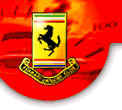  
|
|
Eugenio
Castellotti Remembered
by
John Elliott
9.1.01
When I was a boy (knee high to a grasshopper!), one of the expected
Christmas presents was an annual. Initially it may have been the Beano,
then later the Eagle Annual. I never did progress to Autocourse
annuals but certainly books at Christmas were always welcome. Perhaps
my parents thought they were good for keeping me quiet and occupied
in those days before school started.
This year good Ferrari books have been in short supply for me . I did manage to persuade my wife that Father Christmas could bring me yet another Ferrari book for the shelves and that I would not discard a copy of Keith Bluemel's latest on Ferrari Racing Cars. But this good value publication was not going to tell me anything new or startling. In fact one reason for that acquisition was the selection of photographs. I have many pictures exactly the same since they were taken at the same time and in the same place that Keith took his. It's just nice to see them in a book.
Since I was aware that good reading matter might be in short supply I borrowed from the Club archives some bound copies of the Italian magazine 'Auto Italiana.' Now my knowledge of Italian is virtually non-existent but the contents of these journals make for a fascinating study. The first issue is for the 15th March 1957 with a nice colour photograph on the cover of Canaparo and Midano in a Fiat 8V Vignale, 2nd in the 1300 to 2000 cc GT Class on the Rallye de Sestrieres. There is of course a full account (in Italian) of the Rally but also black and white photographs of Papais and Crivellari who came 8th OA and 2nd in the over 2000cc GT class in their Ferrari GT (S/N 0509GT) and also Lena and Palonga who came 6th OA and 1st in the over 2000 cc GT class in their 250 GT (S/N 0629 GT).
However, it is the second issue in this collection that really caught my eye and sent me searching for an Italian-English dictionary. Issue No.2 was published on the 1st April 1957. The editorial was entitled 'Situazione Grave.' What was the serious problem facing Italian motor sport in the spring of 1957? On the 26th May 1955 the Italians lost one of their greatest racing heroes, Alberto Ascari. Then on the 14th March 1957 they also lost their most promising replacement, one Eugenio Castellotti.
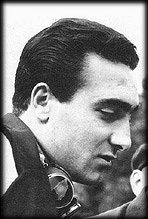 |
|
"Dashingly
good looking, erratic and arrogant"
|
Eugenio was born on the 10th October 1930 in Lodi, Milan. He came from a wealthy family of landed aristocrats. He was dashingly good looking, fiercely competitive and, legend has it, vain to the point of wearing built-up heels in his shoes. He was the archetypal Italian racing driver, fearsome and motivated, erratic and arrogant. He was also one of a generation of drivers, who were pressurized by, and victim to, the personal political strategy adopted by Enzo Ferrari to keep all his drivers on their toes. As I understand it (again my attempts at translation are suspect) it was the Scuderia Marzotto which were to provide the young Eugenio with his 'baptism' into motor racing at the 11th Giro di Sicilia on the 1st April 1951. This was the year that Vittorio Marzotto not only came first in this event but also broke the old record set by Biondetti. However, young Castellotti only appeared in the results as a 'ritirati'.
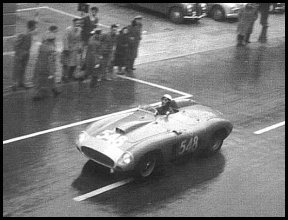 |
|
Castellotti
was always exceptional in the wet
|
At the end of April 1951 he was entered in the Mille Miglia with a co-driver by the name of Rota in a 166 MM (S/N 0058M). With a starting number of 340, the young driver left the ramp in Brescia at 3.40am. Amongst those in his class he would face the already famous Cortese and Marzotto. It rained from the start on this event and there were many damaged and dented cars including the winning 340 AM of Villoresi. Castellotti finished 6th in his class and 50th overall. Nothing to write home about!
Four years later and Castellotti drove the Grand Prix Lancia round the streets of Monte Carlo in the same time as Ascari and then at Spa he was a few tenths of a second faster in practice than the World Champion, Fangio with the unbeatable Mercedes. Castellotti was beginning to show Italy he had the talent. During 1951 and 1952 he drove a variety of Ferrari sports cars including the 225 Sport. On the 9th March 1952 he came 1st in his class in the Giro di Sicilia but 10 days later in the Coppa d'Oro at Siracusa he had a tremendous battle with Sighinolfi. The later, driving for the Marzotto family was forced to retire with a broken axle and Eugenio took his first victory for Scuderia Guastalla. On his second Mille Miglia he drove in the big sports car class (in the 225 S/N 0166) against three Mercedes 300 SL's, Taruffi in his 340 America, Biondetti, Bracco, Faglioli, Caracciola and all of the greats from this era. The run to Pescara was sensational. Kling's Mercedes led but Castellotti was second. It did not last but it was a good beginning.
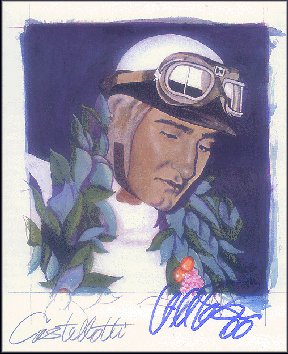 |
|
In
his short time, he was seen as the successor to Ascari
|
At Monte Carlo they had a sports car race instead of the Formula 1 event. For a time it looked as though Castellotti would win. The race was run over the full GP distance and the story goes that Eugenio decided to stop for a Coke. Vittorio Marzotto did not stop and he took first place (in the 225 Sport, S/N 0154 that was present at our Concours last summer), while Castellotti took second place (also in a 225, S/N 0166) and went home with a lesson well learned.
In October 1952 he raced in the GP di Bari where he had a tremendous fight with the American Tom Cole. It was after this race that the press hailed him as the next Italian champion.
By Monza in 1953 he was fifth behind the aces with his privately owned car and as a result, he was invited to join Fangio, Taruffi and Bonetto on the Lancia team for Mexico. He took third place behind Fangio and Taruffi. It was now only a small step to a Grand Prix ride.
In the 1954 Mille Miglia he showed he could master wet roads. At Pescara he was third in the Lancia behind Taruffi and Ascari and heading the Ferraris of Maglioli and Marzotto. After Pescara, he lost oil pressure and tried to make his way slowly to Aqiula where he could take on more oil. If he'd listened carefully to his racing manager he would have known that the spare can in the car contained oil and not petrol as he thought. With a seized engine he had plenty of time to reflect his carelessness.
The 1955 Mille Miglia is known for the great success of Moss and Jenkinson in the Mercedes. But it was Castellotti who overtook the Englishman on the road, having started behind him, and led him to Ravenna by 2 minutes. He went through Verona at an average speed of 124 mph., an incredible speed on those roads. Unfortunately, again his 121 LM Ferrari expired.
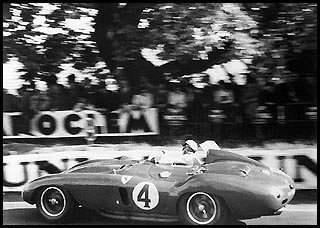 |
|
The
'55 Le Mans drive was quick but ended in retirement
|
At Le Mans he created another sensation by storming to an 800-yard lead on the first lap, and while the car lasted he held off Hawthorn and Fangio.
Lancia, of course, gave him his first ride in a GP car, but after the death of Ascari he transferred to Ferrari. With the Supersqualo he tried to save Italy's honour at Monza, finally coming in third after fight against the Mercedes.
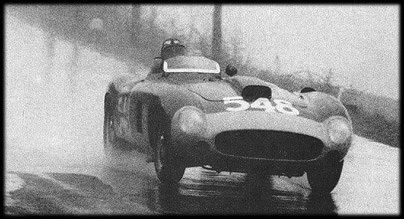 |
|
The
Mille Miglia win was an astonishing achievement
|
1956 was to prove his best season. He eventually scored a victory in the Mille Miglia when he led Collins, Musso, and Fangio home. This was followed by the title of Italian Champion with Ferrari's rebuilt Lancias. Then came the fatal day.
In the early months
of 1957 Castellotti featured extensively in the gossip columns due to
his widely publicised affair with singer Delia Scala. Whilst on holiday
with her in Florence he received
a message to return to Modena to test the latest Ferrari 801 - and to
do something about the unofficial lap record which had just been set
by Jean Behra in the latest Maserati 250F.
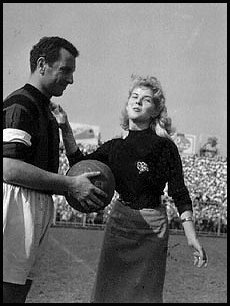 |
|
Femme
fatale Delia Scala
|
Irked at having his holiday interrupted, Castellotti hastened back to Modena in a rather absent-minded and annoyed mood. On the third lap of the test session he crashed into the small grandstand near the chicane at the end of the pits straight and was killed instantly.
No wonder the Italian Motor Press considered the 'Situazione Grave' in April 1957.
I do love old magazines!!
Click here to return to the Ferrari Happenings page.